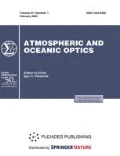Abstract
The use of Landsat 8 satellite imagery made in winter allowed us to detect the existing units for associated petroleum gas flaring in the west of the Tomsk region. The zones of their thermal impact on the landscape of oil fields are determined. A model for estimating regional pollution of territories from a set of sources is suggested. Based on this model and the thermal radiation from flares, the fields of relative pollution of oil-producing areas in winter and summer periods of the year are estimated.

Similar content being viewed by others
REFERENCES
A. Yu. Knizhnikov and A. M. Il’in, Problems and Prospects of the Use of Associated Petroleum Gas in Russia (Vsemirnyi fond dikoi prirody, Moscow, 2017) [in Russian].
I. V. Evdokimov, I. A. Yusupov, A. A. Larionova, S. S. Bykhovets, M. V. Glagolev, and S. A. Shavnin, “Thermal effect of associated gas flaring on biological activity of soil,” Pochvovedenie. No. 12, 1485–1493 (2017).
M. N. Alekseeva, T. O. Peremitina, and I. G. Yashchenko, “Application of satellite data to identification and mapping high temperature oil producing areas in Western Siberia,” Opt. Atmos. Okeana 29 (6), 525–528 (2016).
G. A. Kochergin, M. A. Kupriyanov, and Yu. M. Polishchuk, “The use of Landsat 8 space images for rapid assessment of total flaring volumes of associated gas in the oil-producing territory,” Sovremennye Problemy Distantsionnogo Zondirovaniya Zemli Kosmosa 14 (5), 47–55 (2017).
K. V. Myachina, “Thermal pollution of Ural-Volga steppe landscapes in oil and gas production areas: The analysis on the basis of satellite data,” Problemy Ekologicheskogo Monitoringa Modelirovaniya Ekosistem 28 (5), 44–55 (2017).
I. G. Yashchenko, L. I. Svarovskaya, and M. N. Alekseeva, ”Assessment of environmental risk associated with gas flaring in Western Siberia,” Opt. Atmos. Okeana 27 (6), 560–564 (2014).
M. N. Alekseeva, I. G. Yashchenko, and T. O. Peremitina, “Thermal impact on oil-producing areas of the Tomsk region during associated gas flaring,” Sovremennye Problemy Distantsionnogo Zondirovaniya Zemli Kosmosa 15 (5), 52–60 (2018).
C. D. Elvidge, Estimation of gas flaring volumes using NASA MODIS fire detection products. https://ngdc. noaa.gov/eog/interest/gas_flares.html. Cited January 30, 2019.
C. D. Elvidge, M. Zhizhin, K. Baugh, F. C. Hsu, and T. Ghosh, “Methods for global survey of natural gas flaring from visible infrared imaging radiometer suite data,” Energies 9 (1), 14 (2016).
S. Chowdhury, T. Shipman, D. Chao, C. D. Elvidge, M. Zhizhin, and F. Hsu, Daytime gas flare detection using Landsat-8 multispectral data. http://www.academia. edu/21083575/Daytime_gas_flare_detection_using_ Landsat-8_multispectral_data. Cited January 30, 2019.
E. L. Genihovich, M. E. Berlyand, I. G. Gracheva, V. S. Eliseev, A. D. Ziv, R. I. Onikul, E. N. Filatova, L. G. Hurshudyan, S. S. Chigerin, and E. A. Yakovleva, “Operative model for calculation of long-term averaged concentrations,” Trudy GGO. Is. 549, 11–31 (1998).
N. L. Byzova, E. K. Garger, and V. N. Ivanov, Experimental Research of Atmospheric Diffusion and Calculations of Admixture Diffusion (Gidrometeoizdat, Leningrad, 1991) [in Russian].
V. F. Raputa, G. P. Koroleva, A. G. Gorshkov, and T. V. Khodzher, “Study of the processes of long-term pollution of Irkutsk environs with heavy metals,” Atmos. Ocean. Opt. 14 (6-7), 570–573 (2001).
V. F. Raputa, “Models for reconstruction of long-term aerosol fallout fields,” Atmos. Ocean. Opt. 20 (6), 465–469 (2007).
I. G. Yashchenko and Yu. M. Polishchuk, Poorly Recoverable Oils: Physical-Chemical Properties and Regularities in Location, Ed. by A.A. Novikov (V-Spektr, Tomsk, 2014) [in Russian].
I. G. Yashchenko and Yu. M. Polishchuk, “Classification of poorly recoverable oils and analyis of their quality characteristics,” Chem. Technol. Fuels Oils. N 4, 50–56 (2016).
M. E. Berlyand, Modern Problems of Atmospheric Diffusion and Air Pollution (Gidrometeoizdat, Leningrad, 1975) [in Russian].
A. B. Uspenskij and V. V. Fedorov, Calculation Aspects of the Mean Square Method in the Analysis of Planning of Regression Experiment (Moscow State University, Moscow, 1975) [in Russian].
https://rp5.ru/. Cited February 25, 2019.
ACKNOWLEDGMENTS
Reference data on oil production volumes and gas content in oil are taken from the oil properties database of IPC SB RAS.
Funding
The algorithm for identifying FU in satellite images was developed and the areas of heat-affected zone were calculated at IPC SB RAS within the Basic Research Program of the State Academies of Sciences for 2013–2020 V.46.1.2. “Diagnosis and Restoration of Natural Ecosystems at Oil and Gas Complex Facilities of Western Siberia and Surrounding Regions” (no. GR AAAA-A17-117030310200-4). Simulation of regional pollution zones was carried out at the Institute of Computational Mathematics and Mathematical Geophysics, Siberian Branch, Russian Academy of Sciences, within the Basic Research Program of the State Academies of Sciences for 2013–2020 1.4.1.2. “Development of Mathematical Simulation Methods for Problems of Atmospheric Physics, Hydrosphere, and Environmental Protection.”
Author information
Authors and Affiliations
Corresponding author
Ethics declarations
The authors declare that they have no conflict of interest.
Rights and permissions
About this article
Cite this article
Alekseeva, M.N., Raputa, V.F., Yaroslavtseva, T.V. et al. Estimation of Air Pollution due to Gas Flaring from Remote Observations of Flare Thermal Radiation. Atmos Ocean Opt 33, 289–294 (2020). https://doi.org/10.1134/S1024856020030021
Received:
Revised:
Accepted:
Published:
Issue Date:
DOI: https://doi.org/10.1134/S1024856020030021



